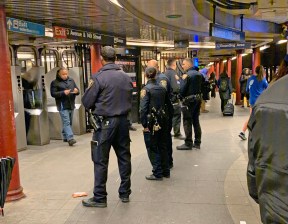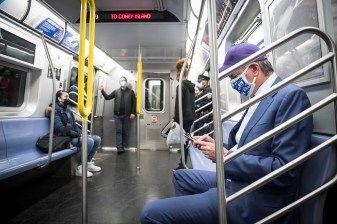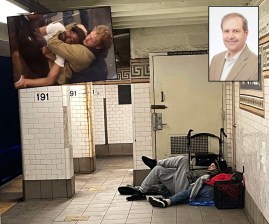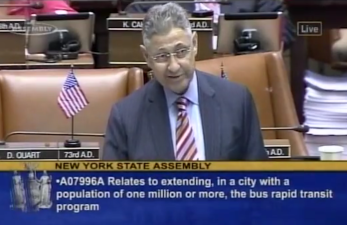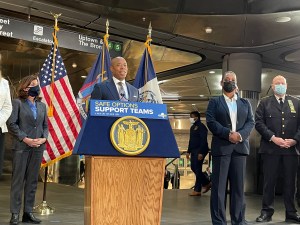After Michelle Go was pushed onto the subway tracks in Times Square and killed on Jan. 15, there was a predictable call to put more NYPD boots on the ground — repeating the same belief that cops can solve a crisis they are ill-suited to fix: the twin problems of homelessness and often-related mental illness.
Yet something must indeed be done.
Go’s alleged killer, Simon Martial, was “undomiciled,” according to police. His sister told the Post that he was diagnosed with schizophrenia “decades ago,” and should never have been on the streets. Yet there he was, in Times Square that day, one of hundreds, if not thousands of people, living with a troubled past, unable to get the help they needed — the consequences of which cost a woman her life.
Meanwhile, ridership remains low, and transit customers tell the MTA that they are frightened. Overall crime is, in fact, down in the subway, but the perception of fear, and the reality of high-profile incidents, is driving the current narrative.
The causes of the problem are many: homelessness, mental illness, open platforms, crime. They all have solutions, but not an easy one.
“Police can’t fix a humanitarian crisis,” said Danny Pearlstein of Riders Alliance. “There will be a humanitarian crisis until we pay to solve it.”
But how? Streetsblog spoke with experts and advocates from several different facets of policy who offered their perspective and solutions to preventing further tragedies.
Creating physical barriers
The most direct way to prevent people from being struck by the train is putting up protective barriers, said Philip Yanos, a clinical psychologist and professor of psychology at the John Jay College of Criminal Justice.
“It would prevent instances of being shoved in front of the train. And there’s a much greater risk of people leaping in front of a train. It’s not an uncommon suicide method in New York City because of the availability,” said Yanos, who has studied and written extensively about mental health and stigma. “We could save a lot of lives if we install those barriers [which are] a standard feature on new subway systems being built. Easily 150 lives would be saved per year, including accidents.”
Since July 2021, the MTA responded to 472 incidents for “persons on roadbed.” And according to stats from the MTA, from January through August of last year, there were a total of 120 incidents of “collision with individual” within the transit system, including suicides, attempted suicides, and people struck. In 2020, there were 169 such incidents, according to the agency.
Platform-end-to-platform-end screens already exist in newer transit systems around the world, like in Europe and Asia, and even right here in New York City, on the JFK and Newark airport AirTrain.
Former MTA board member Charles Moerdler tried unsuccessfully to get them for years — including a plea in 2012 to test-drive barriers in reconstructed stations, like on the Second Avenue line — but the state-run transit agency spent its money elsewhere.
Neither the MTA nor Moerdler could provide a cost estimate for the barriers, but NY1 reported that outfitting just 27 percent of stations with platform doors could cost $7 billion. If that price held, 100 percent conversion would cost $30 billion (before MTA cost overruns).
“They are expensive, but in my view, lives are more important than some of the foolish things the MTA spends money on,” said Moerdler, who served on the board until 2019. “They built a whole subway line on Second Avenue, any one of those could have been used to experiment. They prioritized this below such things as art in the subways, additional people on the administrative payroll.”
Moerdler says the price could be scaled down if the fences only go up high enough to stop people from falling onto the tracks.
“It’s a very much greater cost if the doors go floor-to-ceiling, but why not go only up eight feet?” he said.
The MTA says installing barriers would come with myriad issues, but that the agency is “aggressively” working on other solutions and last month created a task force to do so.
“The MTA has looked at this issue and identified a number of hurdles to outfitting the system with platform-edge doors, including train door misalignment, column placement, platform construction and the need to maintain or create accessibility in accordance with the Americans with Disabilities Act,” a spokesperson said. “Last month, the MTA established a Track Intrusion Task Force to aggressively find solutions for the detection and prevention of incidents of trains striking people on tracks.”
An issue of housing
Homeless people seeking shelter in the subway system is neither a transit issue nor a policing issue — but an issue of housing that has gone unaddressed for too long, advocates say.
Many New Yorkers choose to sleep on the subways because it’s safer than congregate shelters, where poor conditions make them more vulnerable to violence, or contracting diseases. It’s unclear exactly how many of the roughly 60,000 New Yorkers currently living in the city’s shelter system have a serious mental illness, whether diagnosed or not, but Yanos estimates it’s about 6,000 — roughly double the 5 percent rate among the general population, thanks to issues like institutionalized poverty, he said.
And the most recent estimate from the city’s Department of Homeless Services’s HOPE count last year revealed 2,376 New Yorkers living on the street, including those in the subways. But that number is likely a “significant undercount,” according to Jacquelyn Simone, a policy director at the Coalition for the Homeless.
Homelessness in the subway makes many customers uncomfortable and less likely to ride the trains, but it does not necessarily make them more likely to become crime victims. In fact, crime often goes the other way around, said Simone.
“Not all people with mental illness are prone to violence,” said Simone. “They’re more likely to be the victim than the perpetrator. New York City has failed for decades to ensure everyone has safe, stable housing and, as a result, there are thousands of people sleeping on the streets and transit system. Housing is a fundamental human right.”
An inventory by the federal government in 2020 shows that the city has only 34,100 supportive housing beds — a number that remains insufficient amid the crushing need.
“There’s been no progress on this issue, there’s a deep need for tens of thousands of new units to support the need,” said Yanos.
Not only are more units urgently needed, but the Supportive Housing Network of New York recently revealed that an estimated 10 percent of the stock is vacant, according to Craig Hughes, a senior social worker with the Safety Net Project of Urban Justice Center. Those vacancies may be due to what’s called “creaming” — when providers and landlords reject someone on the grounds that the person will be too much of a burden, often because of mental illness. Many of the rejected applicants end up seeking shelter in the subway, he said.
“The main reason, other than supply, that people on the street virtually never get access to supportive housing in New York City is because of discrimination — taking applicants who will be relatively easier to house,” said Hughes. “Someone is rejected by a provider because their mental illness, which is what also makes them eligible for the housing, is seen as too burdensome for the providers. So the provider’s decision is to reject the person and keep them homeless. This falls hardest on those who survive on the streets or the subways, and those whose disabling conditions — the same conditions that make them eligible for supportive housing — are deemed too difficult to serve, or for quite literally any other reason a provider decides.”
Another aspect that makes it so difficult to move someone from the streets into housing is red tape. In order to be eligible for supportive housing units with the city’s Human Resources Administration, applicants must fill out onerous paperwork, including providing proof of sleeping in the subway system. But what’s considered sufficient documentation is often arbitrary or not enough, keeping them on the streets, said Hughes.
“One of the things they’ve done is to set extremely burdensome bureaucratic barriers for people to be found eligible for supportive housing. A key issue here is the onerous documentation required to prove street homelessness, which causes many people to be found ineligible because they don’t have proof deemed sufficient of their nights sleeping on subway grates,” he said.
Politicians offer whatever help appears expedient. In May, 2020, during the first wave of the Covid-19 pandemic, former Gov. Cuomo shut down the subway under the guise of keeping it clean — a decision that riled housing advocates.
More recently, Mayor Adams and Gov. Hochul announced that they would create new “Safe Options Support” homeless outreach teams to address crime and homelessness in the subway, with the hope of connecting the unhoused with services and emergency shelter, a challenging effort that had been tried earlier. Hochul also said she aims to build 10,000 units of supportive housing.
The Coalition for the Homeless applauded that announcement, but added that more needs to be done — Simone and other advocates are calling for an acceleration of city and state plans, including the NYC 15/15 supportive housing plan, which would create 15,000 units of supportive housing by 2030, and the NYS 20K plan, which would create 14,000 units of new supportive housing statewide, as well as preserve 6,000 existing units in the next 10 years.
And locating an available bed is often just half the battle — it can take several attempts to get someone to accept the help they need, the efficacy of which depends on the programs and services offered, according to advocates.
“It might be helpful, but the effectiveness depends on what resources are offered. Many sleeping on the transit system don’t want to go to large congregate shelters. We need to expand the supply of safe haven shelters, and have fewer barriers to stabilization beds — single occupancy hotels with private bathrooms,” said Simone.
Crime and the perception of fear
Like Cuomo, former mayoral candidate Andrew Yang similarly played into the narrative that unhoused New Yorkers and those suffering from mental illness are dangerous — claiming they are going to “lash out at us.” And after Go’s death, Mayor Adams said that he too is scared to ride the train because of “homelessness.”
“Day one, Jan. 1, when I took the train, I saw the homelessness, the yelling, the screaming early in the morning, crimes right outside the platform,” said Adams, who still does ride the train frequently.
The Manhattan Institute’s Nicole Gelinas contends that the decrease in ridership is contributing to the increase in crime on the subway — a reverse safety-in-numbers phenomenon. Before the pandemic, the subway used to carry more than 5.6 million each day. Today, ridership is less than half that.
“Low ridership itself is creating a greater opportunity for violent crimes. People who might be tempted to commit a robbery [have] more space to do so — they’re not stopped by a large crowd of people,” she said.
Violent crimes like murder, felony assault, and rape are up since 2018, according to stats from the NYPD. Last year, there were eight murders in the transit system, up from just one in 2018, three in 2019, and six in 2020. Felony assaults also increased from 375 in 2018 to 461 in 2021, and the number of rapes also increased from two in 2018 to eight in 2021. And given that ridership is so low right now, crime per 100,000 riders is up even more dramatically.
But some crimes such as grand larceny are actually down — from 1,762 in 2018 to 766 last year, with total reported subway crimes down from from 2,587 in 2018 to 1,778 in 2021, according to Detective Denise Moroney, a spokesperson for the NYPD.
The overall decrease, though, is anything but comforting given the decline in ridership, Gelinas said.
“The public does not feel safe. The risk of becoming a crime victim is much higher than it was a few years ago,” she said.
About 2,500 officers are currently assigned to the NYPD’s Transit Bureau to patrol the subways, and following the mayor and NYPD’s announcement earlier this month, more than 1,000 additional cops have been deployed each day “to keep New Yorkers safe,” said Moroney.
But more than the beefed up police presence, Gelinas says, the city also needs to expand drop-in centers for unsheltered New Yorkers, and be able to peacefully escort those in the subway system to them. She also said cops need to do more to secure the gate.
“We have to have more police enforcement to secure the fare gate,” Gelinas said, though she added that no one should be sent to jail for fare evasion, which is typically a “crime” of poverty. “It cannot be an option to live in the transit system or loiter.”
Go’s death was tragic, horrific and could have been prevented. But statistically, New Yorkers are more likely to be killed by a car driver than they are to be pushed onto the tracks. In 2020, 243 people were killed in vehicular crashes on the streets of New York City; and in 2021, at least 266 people were killed. Yet people look for the boogeyman to blame, said Yanos.
“It’s indicative of our society’s need to explain things as ‘other’ that are not us. (Barriers) would actually solve the problem, it wouldn’t just solve the psychological need to blame a group,” Yanos said. “Speaking as a New Yorker, you’re at a much greater risk of getting hit by a car crossing the street than dying in the subway, but things that cue fear are an unkempt person, general dirtiness of the subway, not a giant SUV.”
Like traffic violence, there is a means to an end to preventing more fatalities in the transit system — including people who meet a fate similar to Michelle Go, and those who jump to their death. The solution isn’t quick or simple, but it does exist — it’s putting up barriers to physically stop people from jumping, falling, or getting pushed onto the tracks, and giving people a roof over their head, said Yanos.
“Barriers would make a huge difference, being able to house tens of thousands more people would make a huge difference,” he said.
After an MTA board meeting on Wednesday, during which officials repeated the difficulties of installing barriers on subway platforms, Riders Alliance issued a statement calling for the city and state to finally come up with a plan that addresses the root cause of the problem — homelessness. No cost is too great, the transit advocates said.
“Riders need a plan from the governor and mayor to house and provide healthcare to New Yorkers living on the subway. No frontline outreach effort, whether by police officers, social workers, or some combination, can end transit homelessness by itself,” said Pearlstein. “Ending transit homelessness is one of the worthiest investments the state and city can make in New York’s recovery. Rebuilding ridership will take renewed funding for the affordable, frequent, accessible transit service that New Yorkers need and deserve.”

